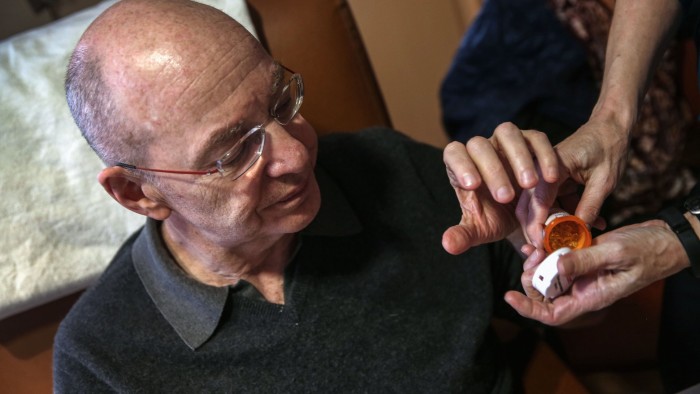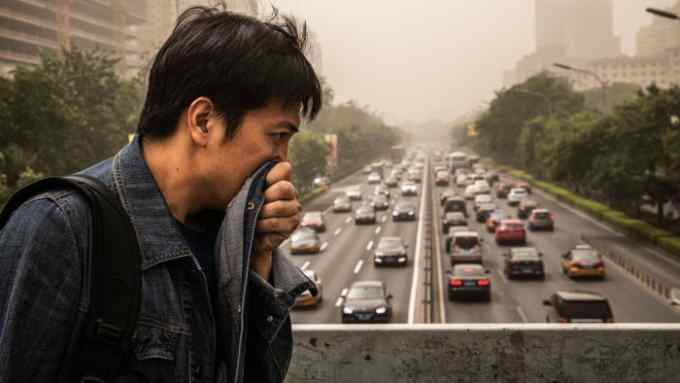Drug costs prompt fears of ‘financial toxicity’ in cancer care

Roula Khalaf, Editor of the FT, selects her favourite stories in this weekly newsletter.
Chemical toxicity has now been recognised as a side effect of cancer treatment but a radically different risk is being talked about by US doctors and cited in medical journals: financial toxicity.
The term is gaining fresh currency in the political arena, too. Scott Gottlieb, President Donald Trump’s appointee as the head of the Food and Drug Administration, summarised matters bluntly in a speech to the Community Oncology Conference in Maryland in April.
“The true purpose of insurance is to shelter patients from financial ruin in the event of a catastrophic illness,” he said. “But the perverse reality of the market today is that cancer treatment comes with its own financial toxicity.” He added that he did not think that “any patient should be penalised for their biology”.
Dr Gottlieb’s remarks signal concern among policymakers, as well as physicians and patients, about the price and affordability of cancer drugs. These affect countries around the world, from the richest such as the US to the poorest African nations.
There have been significant advances in cancer care, with patients living longer, in part because of innovative and more effective medicines. Yet drug prices — with treatments often exceeding $100,000 a year in the US — and greater use of combinations of medicines guided by more sophisticated diagnostics have substantially pushed up the costs.
The trend in the US has been for health insurers to raise premiums and exclusions, such as a higher excess covered by patients before any reimbursement is offered, and larger co-payments and deductibles when it is. That, coupled with losses in income during treatment as patients take time off work, adds to the pressures on patients.
While the so-called Obamacare reforms helped extend insurance cover to millions of Americans who were previously excluded, many cancer patients remain uninsured or underinsured. That leaves them facing drug prices that are all the higher for not having the discounts negotiated by intermediaries.
The only alternatives for many are patient assistance programmes offered by pharmaceutical companies, or support from charities. These fail to satisfy patient demand because of the stigma perceived by some people in applying for help, the bureaucracy involved and the strict requirements that may exclude patients who are truly in need .
In the academic journal The Oncologist in 2013, a study of cancer patients seeking help with co-payments found that 42 per cent reported a significant or catastrophic financial burden. To help meet their costs, 68 per cent cut back on leisure activities and 46 per cent on food spending and clothing; 46 per cent dipped into their savings and 17 per cent sold possessions and property.
Another analysis suggested half of cancer patients on Medicare — the national insurance scheme for the elderly — spent at least a fifth of their income on out-of-pocket expenses relating to treatments.
More generally, the costs of medicines mean patients may not undergo the most effective treatments, or fail to purchase and take the full doses prescribed for their cancers, reducing their likelihood of extended survival.
In a paper in The Oncologist last year, Jeffrey Peppercorn from Massachusetts General Hospital in the US, emphasised that high drug prices imposed on patients may lead them to undergo treatments “based on socio-economic status not medical need”.
He also stressed the need to distinguish the rising societal costs of cancer care from the specific US problem of high costs for patients with inadequate insurance cover. Dr Peppercorn concluded that the burden on doctors to explain cost risks, for example, compromised the doctor-patient relationship, increased the burdens of a cancer diagnosis by adding additional stress to consultations and increased disparities in cancer care by steering patients to options linked to their ability to pay as much as to the best medical treatment.
In Europe the high cost of cancer treatment has also had a negative impact on patients. Agencies that scrutinise the cost and clinical effectiveness of new medicines, such as the National Institute for Health and Care Excellence (Nice) in the UK, periodically refuse or delay the uptake of costly drugs.
In countries without widespread healthcare coverage, access by patients to cancer drugs is yet more limited. There is evidence in some poorer countries that health services purchase sub-standard medicines in order to obtain cheaper supplies.
In a number of countries, patients may use the internet to gain access to drugs from abroad that are outside regulatory scrutiny. Cases in the US indicate that doctors have prescribed drugs “off label” outside normal clinical guidelines in order to cut costs.
Thomas Cueni, head of the International Federation of Pharmaceutical Manufacturers and Associations, the global industry trade body, stresses that drug companies need to generate sufficient returns to invest in innovation. He adds that spending on cancer drugs is relatively modest, representing only about 1 per cent of total healthcare costs.
He says, however, that companies are exploring such avenues as outcomes-based payment, namely aligning drug prices more closely with the health improvement they generate. He adds that they also seek to offer more affordable prices in lower income countries.
“There is clearly a willingness among companies to adapt their models and make sure patients have access,” Mr Cueni says.
If drug companies are beginning to change, the financial services industry and employers also need to do more for patients who have survived cancer. Even patients who are successfully treated, often at significant cost to their families’ financial welfare, frequently find their medical history limits their employment opportunities and their access to insurance and borrowing.
While newer cancer breakthroughs are helping improve the health of some patients, expensive new drugs are also causing a financial toxicity that has direct and long-term implications for their income as well as their health.

Comments